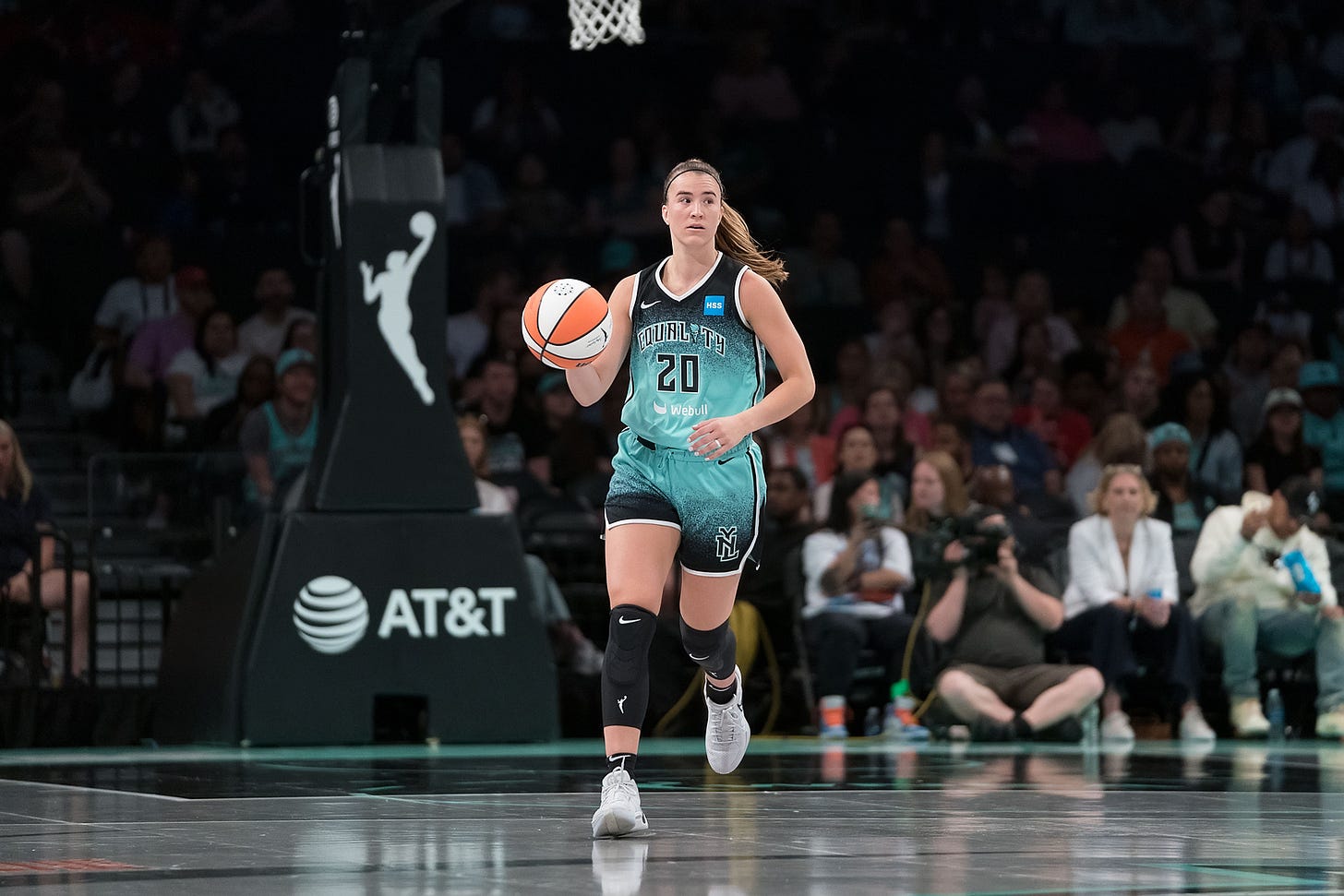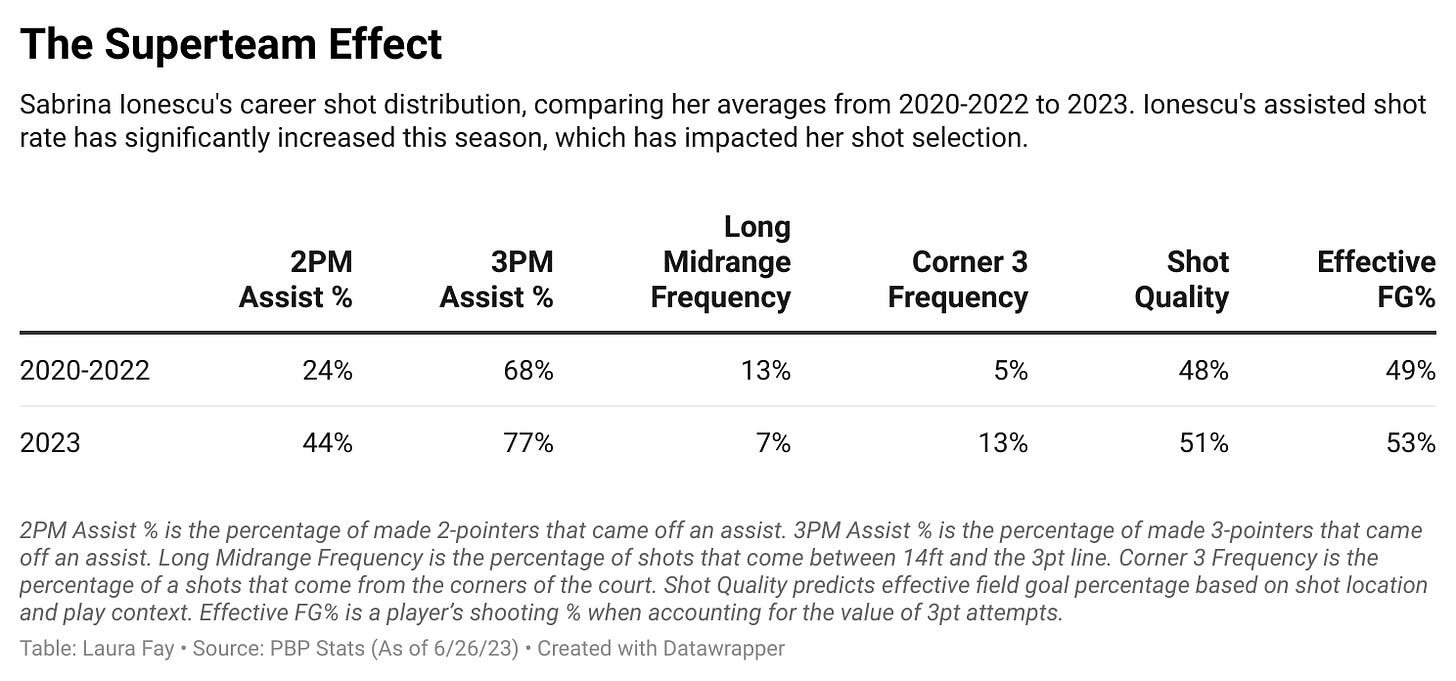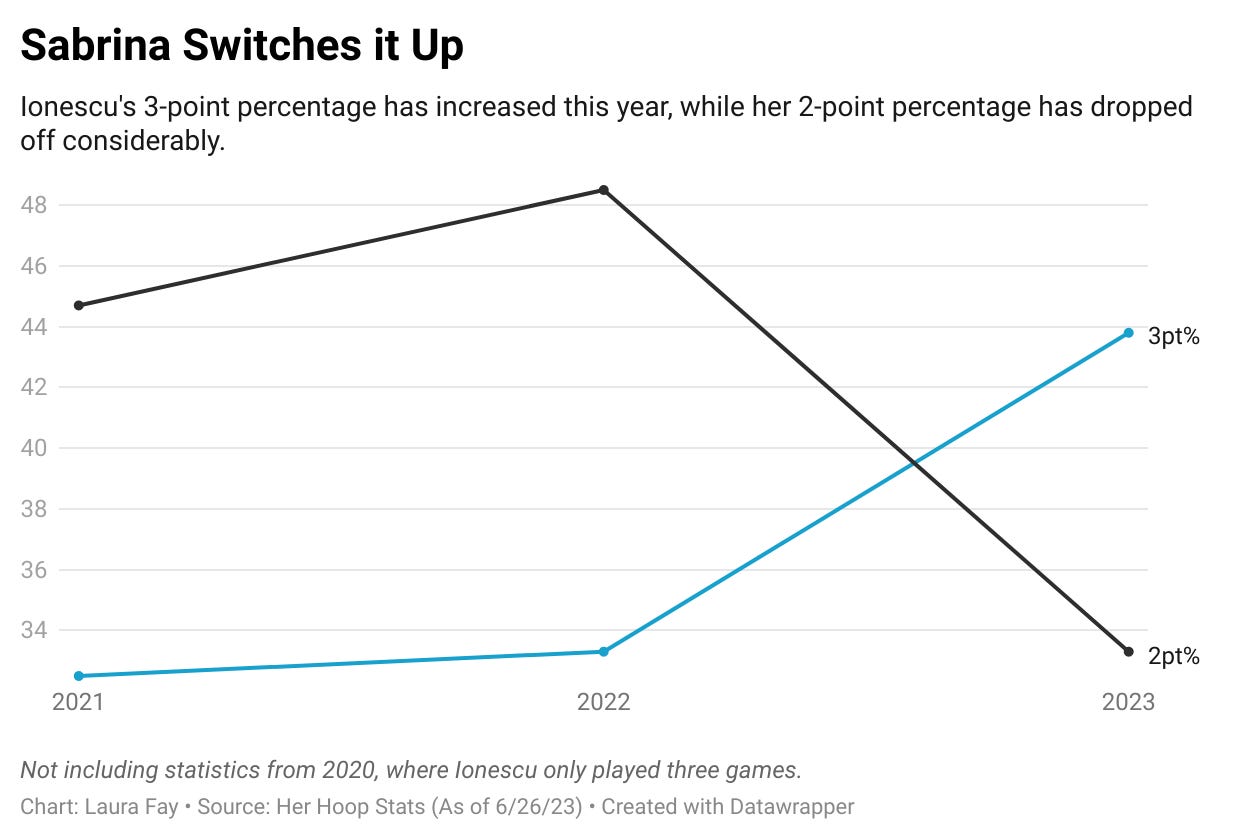Sabrina Ionescu’s Shooting Shift Exemplifies the Tradeoffs of Assembling a Superteam
As New York works to find its team identity, Ionescu is taking on a different role for the franchise.
Thanks for reading the Her Hoop Stats Newsletter. If you like our work, be sure to check out our stats site, our podcast, and our social media accounts on Twitter, YouTube, Facebook, and Instagram. You can also buy Her Hoop Stats gear, such as laptop stickers, mugs, and shirts!
Haven’t subscribed to the Her Hoop Stats Newsletter yet?
Building a super team is never easy. It’s a high-risk, high-reward endeavor, one that sinks quite a lot of time and money into one goal: bringing home a championship. It also requires an adjustment period. Assembling a team of superstars means players that were once the centerpiece of their respective franchises now have to figure out how to work together.
For New York this season, Sabrina Ionescu has had to make those adjustments. That’s not to say Ionescu’s numbers have dropped off. Assists are the only main statistical category where her average has decreased, and that’s likely because Courtney Vandersloot has taken over the main ball-handler responsibilities.
But while Ionescu is scoring a similar number of points as last season, where she’s scoring those points from has almost entirely flipped. From inside the arc, her 2-point attempts per game have decreased from 7.3 to 5.4 from 2022. However, she’s made up the difference by averaging a career-high eight 3-point attempts per game. So while Ionescu’s 17.1 points per game is right on par with her past season averages, that number alone obscures the changes she’s made to her game to get there.
So, what’s driving the change in Ionescu’s shot selection? It’s difficult to say for sure, but Ionescu is playing a different role for the Liberty than she has in past years. With Vandersloot joining the team this offseason, Ionescu has largely been relieved of the primary ball handler duties that she shouldered during her initial years with the franchise.
Now having taken on more of a 2-guard role, she’s been on the receiving end of assists much more than the facilitating side. It shows in the stats. Ionescu’s 2-point makes are being assisted 44.4% of the time this season, an almost 18-percentage-point increase compared to 2022. While slightly less drastic a turnaround, her triples are also being assisted more; 77% of her threes this season have been assisted, a 13 percentage-point increase from 2022.
While Ionescu did play a good amount of 2-guard last year alongside Crystal Dangerfield, Dangerfield averages significantly fewer assists per game than Vandersloot. For comparison, Dangerfield averaged 2.6 assists per game last year, while Ionescu averaged 6.3. Therefore, while Ionescu played less traditional point guard alongside Dangerfield, Ionescu was still relied on as the team’s main facilitator. Even throughout her college career at Oregon, Ionescu averaged more assists than the lead point guards she played with.
So far, the transition to a full-time 2-guard is going well for Ionescu, especially from beyond the arc. She’s currently hitting 43.7% of her threes, a new career-high by over 8 percentage points.
Ionescu’s 3-point prowess is likely in part due to playing alongside a pass-first point guard. Three-point shots are more frequently assisted than twos, and assisted threes are some of the highest percentage shots in basketball. While Ionescu created more of her own 3-point looks in past years, having someone like Vandersloot beside her can spread the floor and open Ionescu up for easier shots from deep.
So far, the increase in Ionescu’s 3-point percentage appears to be driven largely by above-the-break threes, where she’s shooting 46.8% this season compared to 33.2% last year. While she’s also taking more corner threes than ever before, she’s still only hitting them about a third of the time. This is an interesting dynamic in itself, given how players generally shoot a higher percentage from the corner threes than those taken above the break, although some individual variation is to be expected. Both Ionescu’s above-the-break and corner threes are being assisted at higher rates than last season.
Playing alongside a true point guard like Vandersloot has also changed the type of shot Ionescu is taking. For the last three years she has shot long midranges, one of the lowest percentage and least frequently assisted shots in basketball, 13% of the time. Now, she’s taking them on just 7% of her shots. In turn, she’s taking corner threes, one of the highest percentage and most frequently assisted shots, 13% of the time. That’s a nine percentage-point leap from last season.
The change in shot quality shows in the numbers. By PBP Stats’ methodology, shot quality uses several factors, including location and play context, to estimate effective field goal percentage. Higher values indicate higher percentage shots. Ionescu has an overall shot quality of 0.51 this year, a notable increase over last year’s 0.48.
That’s not to say switching roles has been seamless for Ionescu. As mentioned earlier, her average assist numbers have taken a hit. She’s also shooting noticeably worse from inside the arc: her 2-point field-goal percentage of 33.3% puts her in just the ninth percentile league-wide.
Some of that drop-off may be because Ionescu is taking shots from different areas of the court. Her average 2-point shot distance is currently down to 7.7 feet, about a foot less than her average from all previous seasons. To be sure, one would expect players to make a higher percentage of shots from closer distances. With her limited number of 2-point shot attempts (she’s taken 54 across 10 games) it’s difficult to tell whether this trend will persist throughout the rest of the season.
Nonetheless, Ionescu’s struggles from two haven’t tanked her overall offensive efficiency. In fact, her effective field goal percentage of 52.6% is on track to be a new career high (ignoring her three-game rookie season). Sunday’s win over the Mystics was perhaps the best showcase of that, as Ionescus’ seven 3-pointers propelled the team to victory despite her also shooting just 28.6% from two.
Bringing in three of the off-season’s top free agents means that there will inevitably be an adjustment period, and for New York, Ionescu bore a lot of that responsibility. And, though there’s still room for improvement, she’s met the challenge head-on.
All numbers in this piece are as of games played through June 26.
Thanks for reading the Her Hoop Stats Newsletter. If you like our work, be sure to check out our stats site, our podcast, and our social media accounts on Twitter, YouTube, Facebook, and Instagram.






